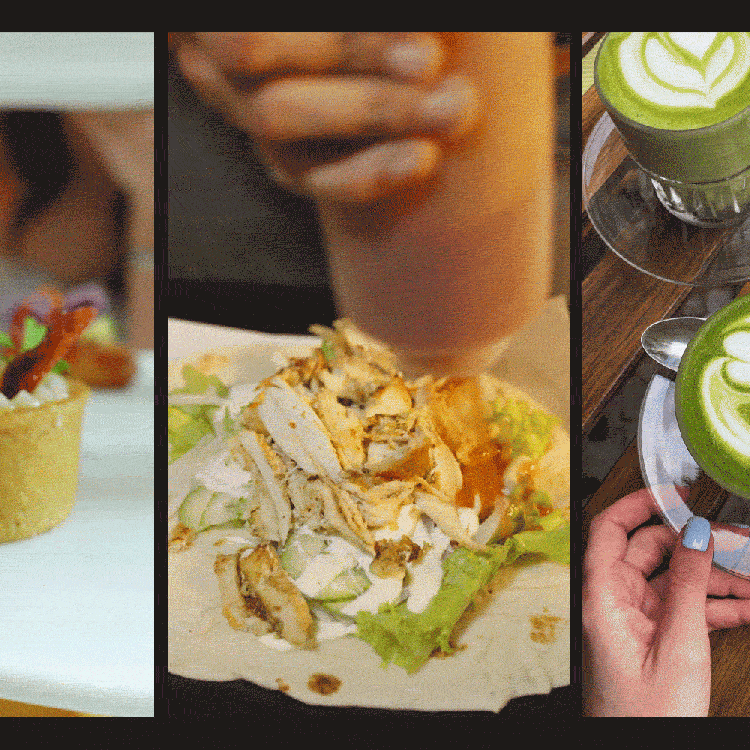Marije Vogelzang wants you to think very deeply about your food — so much so that, for her next project, she’s trained as a hypnotherapist to test if “eating perception” can be enhanced. “This isn’t about working with eating disorders but seeing if we can actually realign our experience of food,” she says. “I want people to come away thinking of food more as a magical material that we should give more consideration to.”
Vogelzang is a leading exponent of a creative discipline you’ve likely never heard of: food design, which is the bridge between an intimate understanding of how we interact with food, and, at the mass consumption level, the products that appear on supermarket shelves. Food design, she notes, is all around us, even though it’s only become more formalized in recent years. The University of Reims recently launched a “design culinaire” course and the Italy-based Food Genius Academy opened its third “food innovation” school in Shanghai. Later this year, Vogelzang, who’s also the founder of the Dutch Institute of Food Design and author of Lick It, will take up a professorship at the University of Kassel in Germany.
“It’s not just foods like gummy bears or Cup Noodles that have been designed, even if we don’t tend to think of these products as having been designed at all,” Vogelzang says. “Increasingly, there’s more design in our various food cultures, from finding ways for indigenous crops to survive to ways in which food scent and flavor can drive memories in geriatric care. And agriculture has been a process of design, too. Tomatoes, for example, are not naturally red as we think of them being.”
Indeed, food design responds to macro trends — food has become an expression of identity and of fashion; we’re more mobile now, so we eat on the move more often; we’re seeing work and leisure blur and may have less time to prepare food; and we’re an aging population and may need foods that are easier to eat or more digestible. But it also responds to micro trends, most keenly that our consumption is so often shaped by commerce’s emphasis on novelty, at least in packing and presentation.
This explains, in part, why foods once considered exotic — kale, kombucha, kimchi, quinoa or tofu, for instance — suddenly went mainstream and why some 50% of mass-market food sales today concern products that were unknown just five years ago, according to a study by the SIAL International Food Fair. It’s also why most of the new foodstuffs we see on the shelves are gone within two years, unable to find a foothold in our kitchen cupboards. But some ideas do stick. Rolled ice cream, bubble teas, cronuts, nut milks, lab-grown meats and soy-based meat substitutes were largely unheard of a couple decades (or even a few years) ago but have responded to shifts towards more functional, healthy and ethical eating, social media’s fostering of a new fascination for the way food looks, and our built-in desire to consume sugar.
More recent ideas have included the likes of lettuce ketchup, cabbage marshmallows, fruit made chewy or reconstituted as aspic-like blocks for easier portability, or snail sausages. Or how about the idea of black milk, printed toast, fries that are made of rice, a burger shaped to remind the eater of the meat’s origins (ideas from Studio Minale-Maeda) or cereal eggs, double-headed lollipops and flavored twigs?
Given the huge problem of food waste, other proposals have repurposed foods that have typically been considered disposable, like the stems of oyster mushrooms. They even use tech to invent entirely new foods. Bezalel Academy of Arts and Design graduate Meydan Levy has proposed “neo-fruits,” 3D printed skins made of cellulose that are injected with vitamin- and mineral-enriched liquids. Or there’s Carnegie Mellon University’s Morphing Matter Lab’s experiments with the transformable quality of flat-packed pasta because the shape of a food determines, in part, the energy required to cook it. “Food is a kind of smart material — it transforms when it takes on water or is cooked,” says Lining Yao, head of the Morphing Matter Lab. “It’s basically a bio-material with many components to play with. Creative thinking is required to make new ideas in food comfortable for consumers to embrace, and that’s not easy in a food industry that’s rather conservative to start with, especially given more recent pressures on innovation [that come from] the likes of rising food prices.”
How to Taste Everything (and Not Sound Pretentious)
How taste expert Mandy Naglich demystifies whiskey, beer and moreVogelzang has also proposed the concept of “vegetable animals” to help us consider meat substitutes more positively as their own category, rather than as second-class alternatives to the real thing. A recent experiment saw her dye cubes of different vegetable matter black and stimulate her test subject’s olfactory sense while they ate them. How did color, or lack of, shape our perception of the food? Could a synesthetic response be prompted?
“I would argue that understanding how we interact with food — ‘eating design’ rather than simply ‘food design’ — really matters, and much more so than established design disciplines like graphic or web design,” Vogelzang says. “Food is elemental. So it’s incredible how under-explored the potential of design in food has been so far.”
“I still have difficulty explaining what I do because this isn’t product design,” says food designer Annelies Hermsen. “It’s more about getting in front of the processes and using intuition and understanding of the changes in how we live in order to develop new products. It’s about bringing two sides together: the food producers who often find it hard to match their product type to changing consumer needs, mostly because of the inflexibility of their processes, and consumers who can be reluctant to explore new ideas in food. It’s about encouraging both to be more speculative.”
Hermsen points out that this new discipline has to work with the facts that we’re psychologically hard-wired to be initially cautious of newness in food and that we’re extremely habitual in our relationship to it. And then there are the cultural variances, too. Some cultures have a history of interacting with others and seem more ready to embrace new ideas, but others lean into defined ideas as to what constitutes food and what doesn’t. That’s why when Hermsen recently experimented with a bone broth made from male goat — typically discarded by the goat milk industry — her test subjects said they liked the flavor but admitted they would nonetheless prefer to buy chicken or beef broth.
It’s not just us consumers who need to be coaxed towards greater openness to new foods, either. Other food design ideas are proposed to challenge the food industry’s conception of what food is and how we relate to it. The problem, argues Edouard Malbois — of the Paris-based food design agency Enivrance, which has worked on concept foods for the likes of Lavazza, McDonald’s and Nestle — is that the food industry still largely aims to produce “alternatives” in categories of already established foodstuffs rather than break any mold with something original and better.
“The industry is stuck using the same production methods with the same over-production,” Malbois says, who recently launched his own innovation, Grand Jardin, cold-infused teas served from wine-style bottles. “It’s true that models of the food industry don’t change easily, but food design has to lead the way in thinking anew about what we invest in food, the way we make it, what we expect from it.”
Carolien Niebling, food designer and author of The Sausage of the Future and a forthcoming book on food textures (published by MIT, spring 2024), argues that this young, progressive discipline is also necessarily campaigning for positive change of the industry and the consumer alike. First off, she argues that food design could help us recover a fundamental understanding of the mechanics of food. What is fermentation? How does cheese become yogurt? For all of our obsession with fancy restaurants and complicated dishes, the basics appear to have been lost.
“Then we would have more confidence in new foods and less need to put our trust in whatever the food industry tells us,” Niebling says. “But the food industry itself also needs to understand that designers — and not just food scientists and developers — are increasingly necessary to help drive not just consumer acceptance, but production efficiencies and commercial benefits, too. When the furniture design industry needs a chair, it doesn’t ask someone in marketing. But that’s what the food industry does, which leads to lots of wrong assumptions about what consumers will accept and in turn limits the food diversity that would be better for nature, our bodies, the whole food system. Food design may be a new discipline, but it’s the missing link that could make what and how we eat so much better.”
Every Thursday, our resident experts see to it that you’re up to date on the latest from the world of drinks. Trend reports, bottle reviews, cocktail recipes and more. Sign up for THE SPILL now.
























